Make Old-Fashioned Brine Fermented Pickles Like Your Great Grandmother
I’m standing at the kitchen counter of the cabin my husband built for us when we moved off-grid. It’s over 90 degrees, it’s approaching the lunch hour, and my three children, aged 1 – 6, are getting hungry.
A set of red headed pigtails is at my side while I chop the mid-summer vegetables that need preserving – summer squash, cucumber, and a few green tomatoes that came off the vines too early. They’re all going into a gallon jar of pickles that will contain no vinegar, will never be heated or boiled, and will not see a lick of refrigeration.
These are old-fashioned brined lacto-fermented pickles. It’s a mouthful, in more ways than one, but these are the pickles our great grandmothers made. They keep for months, if prepared properly, I really appreciate the health benefits we enjoy from them, and though I’ve made them for years, I appreciate them even more now that we’re taking a crack at this sustainable off-grid homesteading life.
Oh and they are dead easy to make.
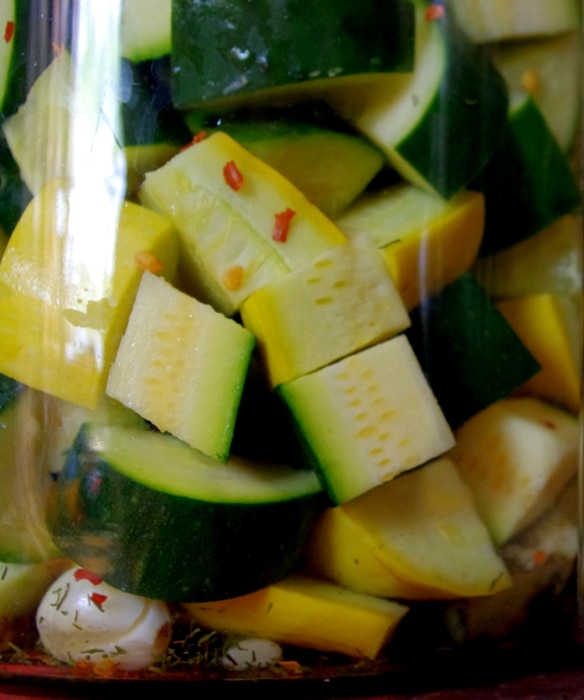
The process of lactic acid fermentation is part art and part science. You’re probably familiar with sauerkraut and kimchi. By the same biological process we can make brine-pickled vegetables from literally whatever is in the garden.
The same beneficial organisms we find in good soil are on the surface of the vegetables we pick. Those beneficial organisms feast on the carbohydrates in the vegetables and produce organic acids as well as enzymes and beneficial bacteria.
It is the acids produced – part lactic and part acetic – that form the brine that preserves the vegetables from spoilage.
This process must happen anaerobically, outside of the presence of oxygen, which is why the vegetables are covered in a salt brine. This is the most critical aspect of the fermentation process: you must keep your vegetables covered in brine.
Beyond that, the process is unbelievably easy.
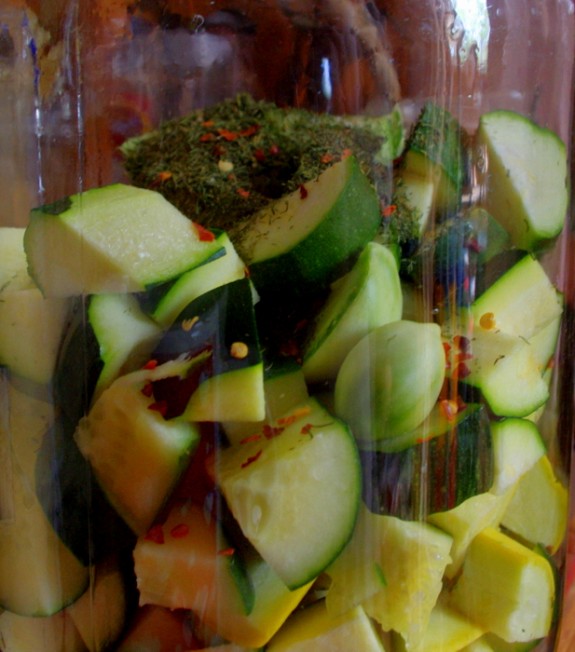
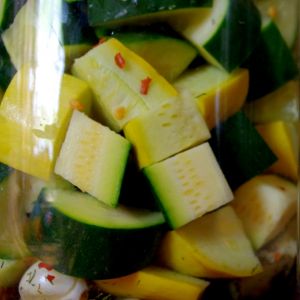
Make Old-Fashioned Brine Fermented Pickles Like Your Great Grandmother
Ingredients
- Salt for brine
- Seasonal garden vegetables
- pickling spices
- leaves for crispness
Instructions
- Prepare a brine using the ratio of two tablespoons of salt to one quart of water. If it is over 85 degrees in your kitchen, use one extra tablespoon of salt. Stir well and set aside.
- Chop vegetables into sticks or bite-sized pieces.
- Gather flavorings – garlic, onions, fresh herbs, or your favorite pickling spices.
- Add garlic, herbs, and spices to the bottom of your clean quart, half-gallon, or gallon jar.
- Add one of the following to keep your vegetables crisp: grape, horseradish, oak, black tea (yes the kind you drink), or mesquite leaves. Read more on why at the Cultures for health blog.
- Place chopped vegetables atop flavorings, leaving at least 2 inches of headspace from the rim of the jar. Pour the brine over the vegetables so they are covered by at least one inch. Two to four inches is even better, but hard to achieve in quart jars.
- Weight down your vegetables so they stay below the brine while fermenting. I have used small plates that will fit into the jar opening, inverted plastic jar lids, a large cabbage leaf, root vegetable slices, or glass weights made specifically for this purpose.
- Cap the jar tightly and allow to sit at 65-85 degrees for around 10 days, or more, depending on your preference. The longer they ferment at room temperature, the sourer they become. Read more on how to tell when they are done.
- During the earliest stages of fermentation carbon dioxide is released. Check your jars once or twice a day to see if the lids are building up pressure. If you cannot press down on the canning lid as you normally would, very quickly and carefully “burp” your jar by slightly unscrewing the lid, allowing a bit of gas to escape, and screwing it back on quickly.
- Once completed, move to cold storage – a root cellar, a basement, a cool garage, anywhere below 65 degrees, or yes – a refrigerator.
Looking at that list of 10 to-dos can be intimidating, but I promise you that once you do this a few times and understand the process, it is the easiest way of making pickles with whatever produce you have and in whatever size batches you need.
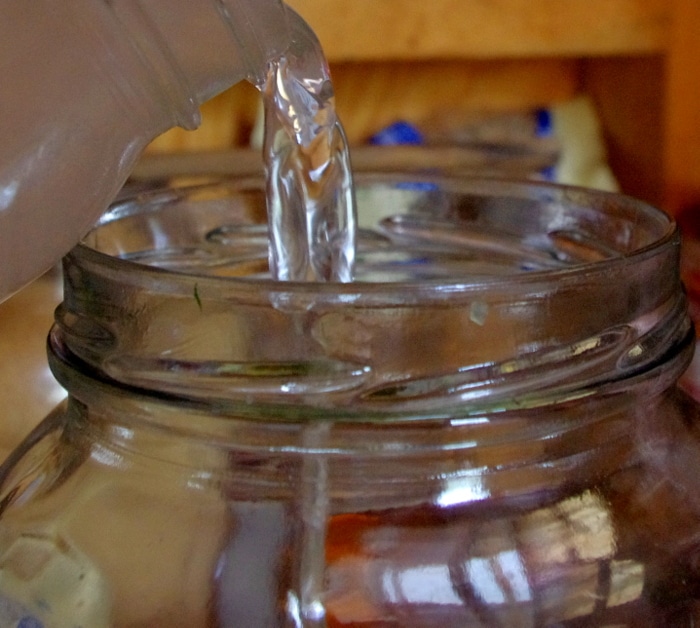
If you’re interested in more specific recipes to get started with, here are a few of my favorites:
- Lacto-Fermented Kosher Dill Pickles
- Lacto-Fermented Summer Squash
- Lacto-Fermented Southwestern Carrot Sticks
Have you tried making pickles without turning on the canner?

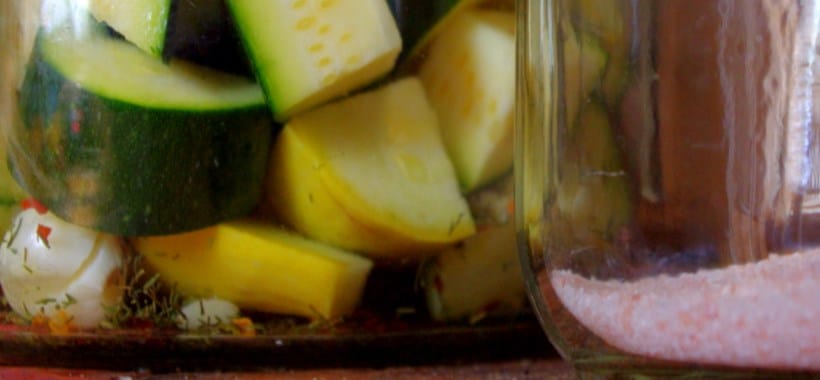
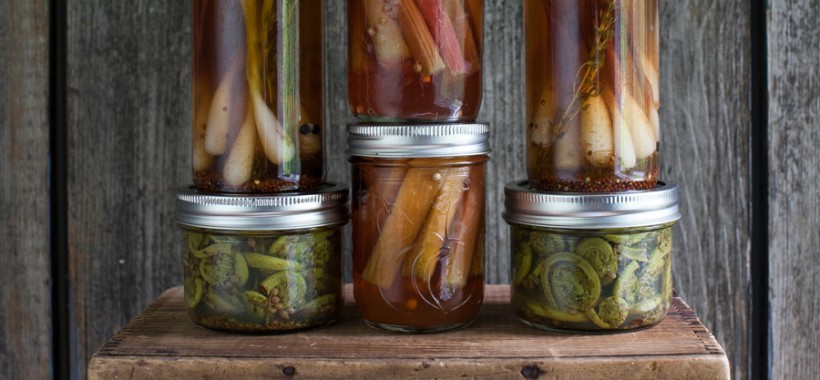
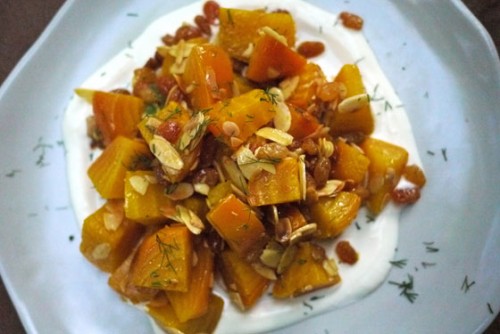
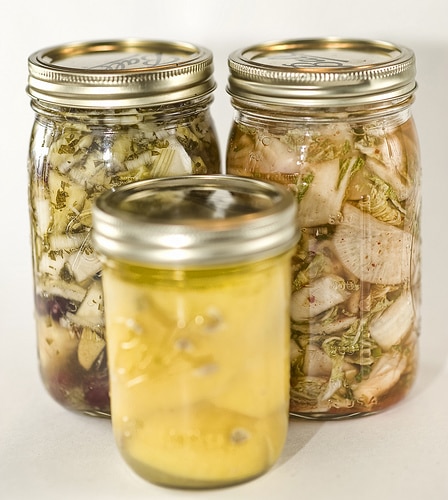
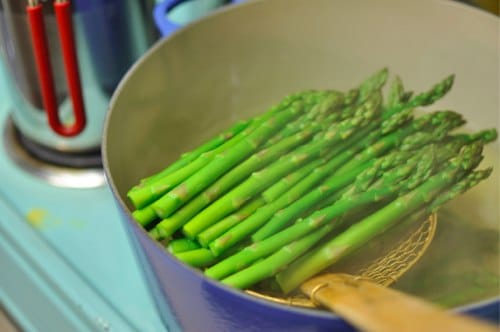
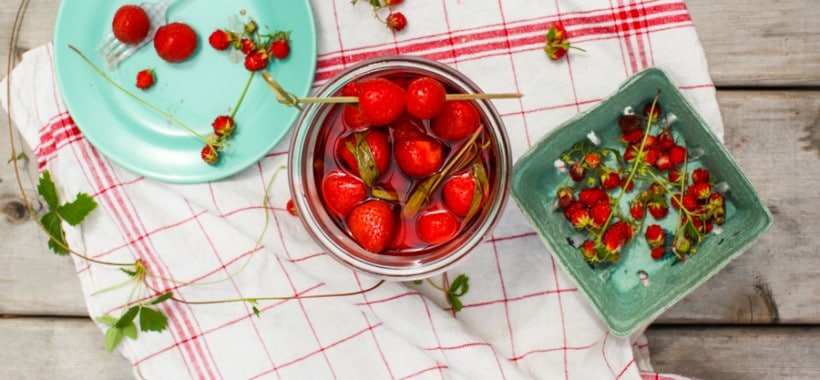
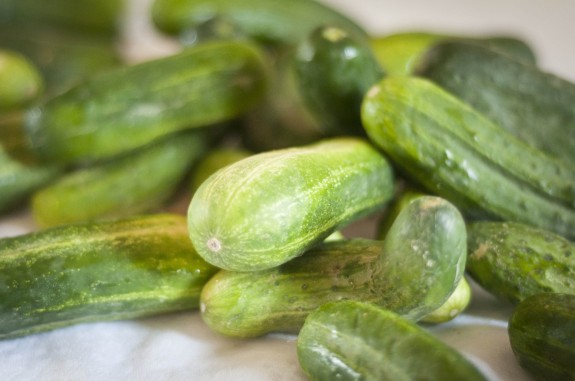
can we add green tea leaves instead of black tea leaves?
Green tea lacks (almost all of) the tannins which are the reason for including the tea. The steaming process which halts the tea’s oxidation, leaving it green rather than brown, prevents its development.
That is not correct. To prove this, simply take some green tea and put it in your mouth. Your mouth will have a desiccated feeling from the tannins. I have used Green Tea with great success for crisping pickles.
Are you talking about green tea powder or leaves? Would you know how much for a 5 gal. batch?
Can you use ground leaves in a green tea bag?
You can also use bay leaves.
I’m going to make these. Would I be able to can these pickles even though they will keep without it? I would like to keep them on hand for the entire year. I don’t have the fridge space nor the privilege of a cellar as I live in the city. Also, I have a bunch of red onions I’d like to experiment with. I’d like to know if I can grill them first them brine them? I think it should work since they still have their carbs to feed the fermentation. Any suggestions?
Yes you can can them but the living bacteria will be dead. A hot water can is fine because the pH is low enough. Canned they will last a long time. Just make sure you have the leaves in there to prevent them turning too soft.
I wouldn’t grill them. The reason is it will break down the onion and will be mushy. You can do it though, it will ferment, just no oils should be present, this will promote off flavors and encourage spoilage over the long run. What you might try is grill a few really well, like char them nicely. Blend these with the raw onions, sort of as a flavoring agent.
Definitely going to try this recipe as soon as we get some of our garden harvested. I do have a question, though. What kind of salt is used? I’m thinking that salt in the old days was rock salt or sea salt, and they probably didn’t have any of the fancy salts we have today. I know some of the native Americans used to get water at salt springs and boil it down to make salt. Pioneers learned the process as well. Just wondering if iodized salt is a poor choice. What did you use?
Sea Salt or Pickling salt only, not iodized.
Any other ideas about what to use to keep them crisp? And if using grape leaves, how many should I use? and will horseradish root work instead of leaves? they don’t really sell the leaves anywhere in markets.
You can even use Oak or Maple leaves. Yup. 🙂
My baba used cherry leaves. I have also and cold water sour dill pickles fermented same way remain crisp with a snap to them.
In Romania, some people use sour cherry tree branches! ??
Sooo, I used cucumber, jalapeno and carrots in mine. The liquid has turned cloudy. Is that bad?
No. Completely normal and not harmful. I’ve never had a batch not turn cloudy in the 6 years I’ve been making lacto ferments.
This is interesting! I’ve never seen pickles made the way you showed quartered into little pieces like that! I don’t know why i’ve never tried that before. Usually do chips or spears, but I might give that a try next time! Thanks for sharing your recipe!
Check out Bubbies Kosher Pickles. Brine is always cloudy and totally delicious!
I make sauerkraut and cover the jar with a coffee filter while it ferments. Is it ok to do the same with cucumbers?
Mine got a milky film on top, has this happened to you?
Yes this is some form of bacteria. Not harmful, but quite common. Not sure what it is, but it will actually produce a white sediment that persists post-ferment. It will eventually settle out of suspension given enough time. Cold shocking in the fridge helps as well.
It is kham yeast
Is it important for the container to be airtight or can it be covered with a lid without the sealing o ring to rid the gases? I had a friend who said he merely left the lid on loosely.
Yeah don’t worry about airtight. In fact you want it to breathe a little. Just make sure nothing gets in there, that’s really what the cover is for. You want it to off-gas but not get contaminated. The main item of importance is that the liquid be above the pickles as molds, etc, will develop on the surface…but not on the liquid.
Would it be worth using a Wine Vent Air Lock? It’s basically like a double S-Trap under your sink but on a much smaller version. You put water in it and it allows any gas build up out.
Hey there! I just burped my jar of pickled cucumbers (6 days in) and I decided to taste one. The pickles weren’t salty and only had a mildly sour taste. Is there a way to make them salty at this stage of the pickling process?
Thank you!
You can always add more salt to the brine. It will absorb over a period of a few days. I would caution using too much though. This is pretty standard sodium content for pickles, if you go too far it’s not good for you (fwiw)
Also, should have mentioned this in the first comment. Lactic acid production by lactobacter is highly dependent on time and temperature. So colder ferments will produce lactic acid more slowly. However, too high of a ferment and you run the risk of funkier flavors and poorer quality in the texture. Just keep it rolling. It will be fine, just check in on it from time to time. I am a big fan of longer ferments because I like a more sour pickle.
Can I use black tea to keep it crisp instead of leaves which I can’t get and what is the amount per half gallon container?
Not quite sure of amounts you use in your recipe?
Will I get sour pickles with this recipe?
How much pickling spice should I use?
How much garlic etc.
Thanks
Can you use blak tea bags
My husband and i ended up being now cheerful when Raymond managed to carry out his research from the ideas he gained while using
the web page. It is now and again perplexing just to possibly be
making a gift of tips which usually people may have been selling.
So we consider we now have the website owner to be grateful to for that.
Those illustrations you made, the easy web site menu, the friendships you make it possible to
instill – it’s got all wonderful, and it’s assisting our son in addition to our family
feel that the situation is thrilling, and that is highly serious.
Thank you for all the pieces!
Thanks for finally talking about >Make Old-Fashioned Brine Fermented Pickles Like Your Great Grandmother
| Simple Bites <Loved it!
could the black tea be left in the bag or does it need to be loose?
Hi, I made some of these to a different recipe with a much higher salt content (2 tabspns salt to 1 x 250ml cup of water) and as a result the cucumbers are too salty to enjoy. Do you have any suggestions?
Oh man, that’s happened to me. You can try rinsing them off with tap water before eating.
Hi… Very interesting. Liked your recipe. We made same with green mango in India. I have some Confusion, it would be helpful for me if you clear it. You said “Prepare a brine using the ratio of two tablespoons of salt to one quart of water.” so my question is one quarter of what? Cup….
1 Quart = 4 Cups
Quart = quarter of a gallon
A quart of water (32 ounces of water)
One quart (US) is 946 milliliters (about 0.95 liters or “just less than a liter”). If you have an Imperial Quart measure, then use 0.83 quart(Imperial) to equal a US quart.
Two tablespoons (US) of sea salt is 29.6 dry milliliters by volume or 34.1 grams of by mass/weight. Using weight is going to be more accurate, as salt grain size is not as important. Just use a sea salt or pickling salt without added iodine or anti-caking agents.
Mangos should likely be pickled green instead of ripe. I agree with another commentor that you should be looking for mango pickle, jam or chutney recipes instead of cucumber or similar vegetable or fruit pickles.
Thank you so much for giving the measurement the rest of the world uses. ✌
you said on completion keep them in refrigerator or cool place below 65°f. But in India temperatures varies from 90°to 110°. So what will you suggest?
Second question if I want to make it in bigger quantities like 5kg mangos then it requires cold storage which I don’t have. So what you suggest.
You replied “Yes you can can them but the living bacteria will be dead. A hot water can is fine because the pH is low enough. Canned they will last a long time.” request to explain “what is hot water can” because it will help me for making big quantities for 1 year. Because green mangos comes ones in a year so if we want pickle, it has to be in 5kg quantities and for 1 year use.
Hi Alpesh, I really would not suggest you adapt this recipe for your mango project but instead find someone local who has experience with your specific requests.
Hi Alpesh, the Indian equivalent of what you’re asking is a pickle from Kerala called ‘Vadu Manga’ made from baby raw mangos. It used no oil unlike other Indian pickles anf stays in the hot Indian weather for a year or more.
Goa has a similar recipe for lime picks with just salt that lasts for several years. A search on the internet should give you the recipy for both.
I make an old style pickled watermelon rind from a recipe that my Mom always used. All that goes in it is water that was boiled the night before (I don’t know why this has to be done, but she swore by it), salt, garlic cloves, peppers for heat, dill and pickling salt. Just add the rind to the jars with the above ingredients, seal tightly with a lid and you are done. Some jars that I make turn out too soft and others are just right. Any idea why some work and some don’t? I am trying with different amounts of salt but I thought you might know.
Thanks
Just curious Bill: where was your mother raised? The only watermelon rind pickles I had ever heard of are from the South, where they are universally made as a sweet pickle. Your mother’s savory version sounds delicious, but it’s very unusual. Could you post the recipe? How long to you leave them before eating?
By the way, I suspect the purpose of boiling the tap water the night before was to drive off any chlorine etc. that might have been added to it.
and to cool it.
After boiling and cooling, it might be a good idea to filter the water through a coffee filter or Britta Pot so as to remove any unwanted minerals.
You say “the same beneficial organisms we find in good soil are on the surface of the vegetables we pick” and that it is that bacteria which produces the acids that pickle the vegetables.
Does this mean that vegetables from the grocery store (which often have been rinsed in a chlorine solution) will not ferment? For home-grown vegetables, how thoroughly should they be washed? Is there a risk of eliminating the necessary bacteria?
I don’t think there is anything to worry about Larry. Between when the store bought vegetables were washed and when you get them home, they will have gathered plenty of bacteria from the air to ferment. I usually just do a quick rinse on my garden vegetables, or I use a brush if there is visible dirt. I think as long as you don’t use a disinfectant you will be fine, the lactic acid bacteria are ubiquitous in the environment.
Anyone ever experiment with a lower ph water. I want to try it, but will it upset fermenting process?
First-time fermenter here.
I made these, following the instructions, expecting to mess it up, as I’m not the most talented instruction-follower, but, after four days of in-jar action, they turned out SOOOO good! I’m making a second round today to give to a friend. Hopefully they’ll turn out the same. I sliced my garden cukes (Marketmore), and used wild grape leaves. They’re not super crunchy, but maintained the consistency that they had when picked fresh. Thanks for the great post! I’m now an F4L (Fermenter 4 Life).
Oh, and I used regular tap water (Toronto), with flouride and g*d knows what else…
I have a question. Opening the lids to burp the gas out. How will this not make the pickles bad by breaking the seal?
Do you have to cut up your veggies?
Also the link for your recipe fore Kosher dill pickles is broken. [help]
Hi Gabrielle,
Thanks for letting us know about the broken link. I’ve fixed it.
-DB
Will this work with whole cukes instead of cutting them up?
I have just started my first two ferments (cucumbers) and had a question.
While the beats are submerged just fine, lots of the spices (mustard seeds, pepper seeds…etc) are floating on top of the brine.
Will this cause any issues?
I use wadded up plastic wrap at the top of my jars ….. before I put the lid on to keep everything submerged…
Just made 4 jars with cucumber, and 2 jars with tomatoes, just to see if that works. Looking forward to the results. BTW, the link to your Cultures for Health blog does not work.
How do you add the tea leaves in? Could I break open a teabag of black tea and pour it in the bottom with the rest of the spices?
The link to “how to tell if pickles are ready” is broken.
Fixed. Thanks!
The Culture for Health link is broken.
Hi Sasha,
It seems that they have recently redone their site, as this is the second link I have fixed to their site. It is fixed now, and I’ll have a look throughout the site to redirect. THey have some really good stuff on their blog/learning pages!
Thanks for pointing it out.
Dan Bourque
Tried this four times now. Mold. Every time. Mold. Not one successful batch yet. And I am an experienced dry fermenter which is infinitely more difficult. Not sure what the problem is but haven’t had a usable batch yet.
Thank you for this wonderful receipe. Can I use it to pickle different vegetables like fennels, peppers, carrots ? Thanks for your reply
Thank you for this recipe Jenny! I am going to be doing a run over the summer with fermentation and I’d love to try a variety of different flavors. Whether that be sour, sweet, or dill – I am excited to try them all! Thanks for sharing.
Hi, thank you for this article, I can’t wait for summer produce!
My question is in regard to fermenting and what I’m reading everywhere about a tight cover and burping the jar… I’ve never fermented myself, but my parents used to make sauerkraut (mmm.. the best! ) in a 25 gallon crock in the middle of the kitchen floor, covered and weighted with something, but it was not airtight. The kraut was held down below the liquid and the whole thing was just covered with a dishtowel to keep debris out. Wow did our house smell… anyway, they would check under the towel every couple of days or so, and skim off anything they didn’t like. Eventually it would be deemed finished, and then we would can it…best kraut ever! Sourest kraut I’ve ever eaten. Anyway, it wasn’t covered in an airtight manner at all… so is airtight really necessary? Does it enhance the process in any way, or what is the purpose of airtight? I plan to ferment this summer, and I want to get it right.
Thank you.
Put fresh grape leaves or horseradish leaves in with the cucumbers. The tannin in the grapes leaves prevent the cell walls from breaking down and the cucumber will stay crisp.
Very interesting
But
Is it possible to adapt this recipe to turn cucumbers into sweet pickles because I really don’t like the taste of dill pickles
HELP! Can I add more brine after pickles have been in the jar two days ? My pickles are not completely coved now.
the process is unbelievably easy.
Make these every year when my pickling cucumbers are ready in my garden, they are really great pickles and so easy to make. Thank you!
The liquid has turned cloudy.
KINDA LIFE CHANGING!
This is the best recipe! I have made four batches of fermented pickles this summer, three using this recipe – those three were nearly perfect! BUT the best part is that I can have dairy again if I eat these most days. In my experience, the probiotic foods that have the best health impact tend to be homemade (although WinCo real sourdough bread is a rare exception). These are so easy to make & are fantastic to eat…in addition to just snacking on these veggies, I add them to cacio e pepe, loaded potato cakes, curry, any soup, and all tex-mex dishes.
Yes! This is how I make mine, but I want to be able to eat them all year! Have you ever tried pressure canning them?
Pretty easy recipe to follow. I did a batch of mixed veggies (cauliflower, broccoli, carrots, pearl onions, jalapeno pepper) a few days ago, and it came out great.
Would you have any suggestions concerning pickling spices??
I make Kimchi, Saurkraut, Kombucha & Mlangeni (eggplant) all with garden produce grown organically; so I now look forward to adding your recipe; and am excited to try this as I really love a good old-fashioned crisp pickle.
I tried this with the kids on the weekend, so too early to know the results but just want to let you know we all had a great time making these pickles.
Did not mention which pickling spices.
So I’m really new to this whole pickling thing. My pickles turned out great but I do have a question.
Do I remove the pickles from the brine after 10 days or do I leave them in the brine with the seasonings before canning or putting in a jar in the fridge?
My grandmother pickles a similar way in Sichuan, China! the more you learn….
In sichuan they’ll add ginger, garlic, and Thai chili peppers with a nice sprinkling of Sichuan peppercorns. For an extra zing and umami in dishes, sub in the pickled versions when cooking (pickled ginger or chilis instead of regular!)
I have used this reciepe and it was great!
Can I use the picking juice for anything please.
Is there any reason not to use whole pickling cucumbers with this recipt?